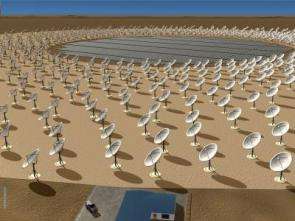Australia, South Africa, short-listed for giant telescope

Australia and South Africa have been short-listed as the countries to host the Square Kilometre Array (SKA), a giant next-generation radio telescope being developed by scientists in 17 countries.
The decision, made by the International SKA Steering Committee, was announced today in the Netherlands. It was based on the recommendation of a special advisory committee of seven scientists from five countries that examined four site bids.
Australian SKA Project Director, Professor Brian Boyle of the CSIRO Australia Telescope National Facility, welcomed the news. "This is a major milestone for the SKA project," he said.
The SKA will be a set of thousands of antennas spread over 3000km, with half the antennas located in a 'core' site of 5km x 5km. The proposed core site in Australia is Mileura station, 100km west of Meekathara in Western Australia. Other antennas would be distributed over the continent; still more might be placed in New Zealand.
The Australian site submission was developed by the Australian SKA Planning Office in CSIRO, with the help of the WA Government and consulting firm Connell Wagner.
"We've got a great site, but we've also got a team that's worked very hard to present its greatness," said Dr Bob Frater, Chair of the Australasian SKA Consortium Committee. "This result is a tribute to them."
A key requirement of the core site is very low levels of man-made radio signals, which could mask the faint cosmic radio waves the telescope is designed to detect. "The West Australian site is better in this respect than any site in the world currently used for radio astronomy," said CSIRO's Dr Michelle Storey, Leader of the Australian SKA Planning Office.
Both the Australian and South African sites can see much of the same sky as the world's other major telescopes. Both have a good view of the southern sky, which is where the centre of our Galaxy goes overhead. And both have stable ionospheric conditions, important for low-frequency observations.
China and Argentina also bid to host the SKA. These sites were considered excellent for radio astronomy but failed to meet at least one of the SKA's exacting requirements.
The final siting decision is expected by 2010.
Source: CSIRO Australia





















